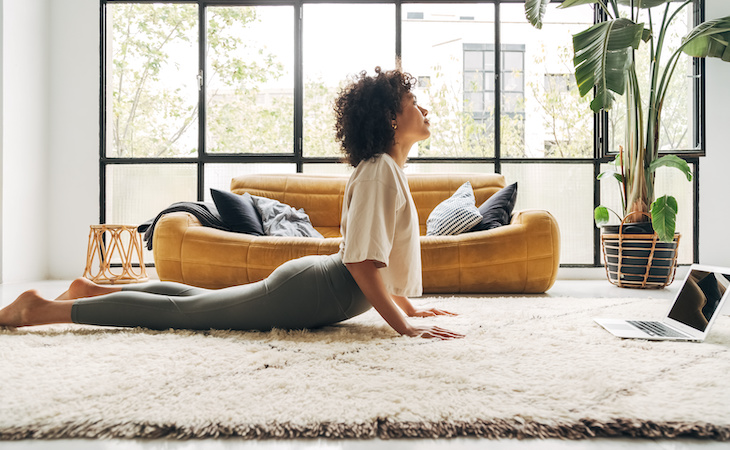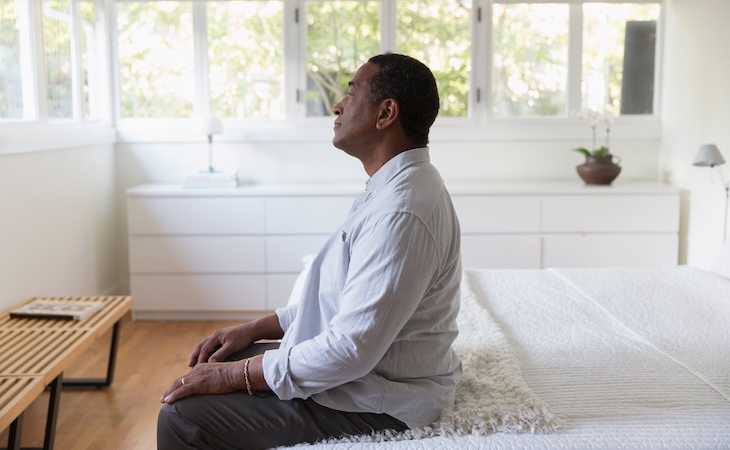I really enjoy yoga—but I have a very inconsistent relationship with it. When I’m in a groove and practicing regularly, I feel great; I feel more relaxed, centered, and overall good (not to mention flexible!). But it doesn’t take much for me to get out of that groove—and when I do, it can be months before I even look at my mat again.
That’s why, every year, I do a 30-day yoga challenge; it’s a way to get myself back into the swing of things with yoga—and while it doesn’t always stick, it’s always a great way to reconnect with my practice.
And while past years have been more general, this year, I went into my 30-day challenge with a specific goal: to practice yoga before bed—and use it to get better sleep.
So, what happened? Did making yoga a part of my pre-bedtime routine ultimately help me catch more (and higher quality!) Z’s?
What is a 30-day yoga challenge?
A 30-day yoga challenge is…well, exactly what it sounds like. It’s a commitment to practice yoga daily for 30 consecutive days.
Yoga challenges can be based on different goals; for example, you might build your challenge around practicing a specific type of yoga for 30 days, practicing for a certain amount of time each day, or mastering a specific move, like crow pose or a full forward fold.
But as mentioned, for my 30-day challenge, I decided to focus on incorporating yoga into my sleep routine—and (hopefully) getting better sleep as a result.
I was pretty loose with my requirements. I didn’t get hung up on what I practiced or for how long; instead, the main goal was to practice close to bedtime—and to do so every day for the 30 days.
The benefits of a 30-day yoga challenge
While everyone is different, there are several 30-day yoga challenge benefits you might experience when you tackle this kind of endeavor.
For example, if you practice yoga consistently for 30 days, you may:
- Increase flexibility
- Increase strength
- Build muscle
- Reduce anxiety
- Reduce stress
- Improve resilience—and be able to better manage stress
- Improve your practice
I know that I experienced all of these benefits over the 30 days I practiced. For example, after about a week or so, I noticed that certain postures were easier, and I had to bend my knees less in downward dog.
I found myself better able to handle day-to-day annoyances that otherwise would have made me feel frustrated. I felt less anxious and more energetic. It was also a fun time to connect with myself (when I practiced alone) and my husband (who often practiced with me).
And, as I had hoped, I got better sleep.
Can a 30-day yoga challenge help you sleep better?
In my experience, my 30-day yoga challenge definitely helped me sleep better—and for good reason.
“The essence of bedtime yoga lies in its power to foster a synergy between the mind and body through relaxation techniques, which eventually leads to improved sleep quality,” says Joanne Highland, a 500+ hour certified yoga teacher from Online Yoga Planet. “It accomplishes this by ridding the body of residual energy, calming the nervous system, slowing the heart rate, and promoting deep breathing, which are beneficial for inducing sleep.”
The biggest impact yoga had on my sleep was helping me get to a place where I was ready to fall asleep. It can be really challenging for me to doze off; I’m the kind of person who gets into bed and tosses and turns for an hour (or more) before fading into sleep.
But I noticed when I practiced yoga shortly before bedtime, I felt much more ready for sleep—and generally drifted off in a few minutes (which, for me, is a major improvement).
Now, it is important to note that I didn’t experience perfect sleep every night. It took a bit of trial and error before I figured out the best way to practice to improve my sleep. And a big part of that came down to the style of yoga I incorporated into my pre-bedtime routine.
When I did any yoga that was super active (like vinyasa flow), I found that it made me feel awake and energized—which isn’t exactly the vibe you want when you’re trying to go to sleep.
“Practices like power yoga, ashtanga, and vinyasa…are quite vigor-intensive, reduce relaxation, and hence can disrupt the preparation for sleep due to their heart rate boosting nature,” says Highland. “It’s advisable to avoid these types of yoga before bedtime.”
Instead, it was when I slowed things down with my practice that I was able to unwind and fall asleep more easily.
Highland agrees, recommending restorative and yin as the ideal pre-bedtime yoga styles. “These styles emphasize deep relaxation and involve slower, more prolonged postures that gently stretch connective tissues, inviting a state of relaxation that may be conducive to sleep,” says Highland.
How to build a regular yoga practice
Not everyone has the time, space, or desire to practice yoga every day. And that’s OK! You don’t have to practice daily to reap the benefits of yoga (including better sleep!); you just need to build a regular practice that works for you.
What, exactly, does that look like?
- Pick a schedule—and stick to it. It doesn’t matter if you opt to practice yoga every day, four times a week, or twice per week. Just choose a schedule that works for you—and then commit to it. “Consistency is key when integrating yoga into a…routine,” says Highland.
- Start small. Trying to go from zero minutes of yoga to 90 minutes of yoga a day can feel overwhelming—and you might give up before you get into a regular groove. Instead, “start small, with just 10- to 15-minute sessions, gradually increasing the time as your comfort and flexibility improve,” says Highland.
- Create the right environment. If you’re using yoga to get better sleep, the environment in which you practice is important. “Opt for a calm and dimly lit space, free of distractions,” says Highland. You can also make the environment more sleep-friendly by incorporating essential oils into your practice. “Using essential oils like lavender or chamomile can stimulate the senses, reinforcing the soothing effect yoga has on the mind,” she says.
- Make it a part of a larger sleep-supportive routine. Yoga can help you get better sleep. But it can’t override bad sleep hygiene habits, like pounding caffeine until 6 pm or staring at a screen through the wee hours of the morning. Instead, consider yoga as part of a larger group of practices that support getting better rest. “Best results are achieved when one considers yoga as a part of their comprehensive sleep hygiene practices, alongside maintaining a regular sleep schedule, following a healthy diet, and keeping screens at bay before bedtime,” says Highland.
FAQs
What happens to your body when you do yoga for 30 days?
No two bodies are the same—and, as such, people will have different results when practicing yoga for 30 days. However, some benefits you may experience include improved sleep, decreased anxiety, increased flexibility, and increased resilience.
How quickly do you see benefits from yoga?
Again, everyone is different—but many people experience immediate benefits from yoga (for example, feeling calmer or more present).
Are there any potential risks or downsides to a 30-day yoga challenge?
Yoga isn’t the right fit for everyone—and before you start practicing, it’s important to get the green light from a professional. “It’s always best to consult with a healthcare provider or a certified yoga instructor to ensure yoga practices align with personal health status and sleep requirements,” says Highland.
Pilates is another form of movement that may help you catch more Z’s. Learn how to practice Pilates for better sleep.




